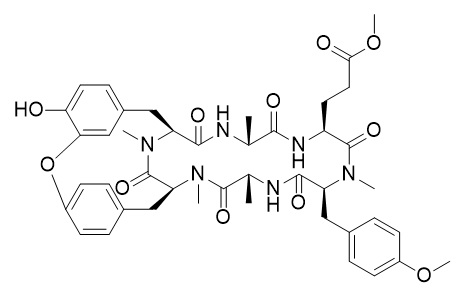Rubiyunnanin C
Rubiyunnanin C exhibits cytotoxic activities against a panel of eleven cancer cell lines and exerts inhibitory activities against nitric oxide (NO) production in LPS and IFN-γ-induced RAW 264.7 murine macrophages.
Inquire / Order:
manager@chemfaces.com
Technical Inquiries:
service@chemfaces.com
Tel:
+86-27-84237783
Fax:
+86-27-84254680
Address:
1 Building, No. 83, CheCheng Rd., Wuhan Economic and Technological Development Zone, Wuhan, Hubei 430056, PRC
Providing storage is as stated on the product vial and the vial is kept tightly sealed, the product can be stored for up to
24 months(2-8C).
Wherever possible, you should prepare and use solutions on the same day. However, if you need to make up stock solutions in advance, we recommend that you store the solution as aliquots in tightly sealed vials at -20C. Generally, these will be useable for up to two weeks. Before use, and prior to opening the vial we recommend that you allow your product to equilibrate to room temperature for at least 1 hour.
Need more advice on solubility, usage and handling? Please email to: service@chemfaces.com
The packaging of the product may have turned upside down during transportation, resulting in the natural compounds adhering to the neck or cap of the vial. take the vial out of its packaging and gently shake to let the compounds fall to the bottom of the vial. for liquid products, centrifuge at 200-500 RPM to gather the liquid at the bottom of the vial. try to avoid loss or contamination during handling.
Vietnam Journal of Science2022,64(2):69-75.
Molecules.2024, 29(17):4034.
J Ethnopharmacol.2024, 318:116863.
Natural Product Communications2021, 16(9):1-10.
Natural Product Communications2020, doi: 10.1177.
Food Sci Biotechnol.2023, 32(9):1215-1223.
Food Quality and Safety2018, 2:213-219
Enzyme and Microbial Technology2022, 110002.
Korean Journal of Medicinal Crop Science2018, 26(5):382-390
Oncotarget.2016, 8(51):88386-88400
Related and Featured Products
Bioorg Med Chem. 2010 Dec 1;18(23):8226-34.
Rubiyunnanins C-H, cytotoxic cyclic hexapeptides from Rubia yunnanensis inhibiting nitric oxide production and NF-κB activation.[Pubmed:
21044847 ]
Six new (Rubiyunnanin C,rubiyunnanin D, rubiyunnanin E, rubiyunnanin F, rubiyunnanin G, rubiyunnanin H, 1-6) and five known (7-11) cyclic hexapeptides were isolated from the roots of Rubiayunnanensis (Franch.) Diels.
METHODS AND RESULTS:
The structures and stereochemistry of 1-6 were established by extensive spectroscopic analyses and chemical methods. All compounds (1-11) not only exhibited cytotoxic activities against a panel of eleven cancer cell lines with IC₅₀ values ranging from 0.001 to 56.24 μM, but also exerted inhibitory activities against nitric oxide (NO) production in LPS and IFN-γ-induced RAW 264.7 murine macrophages with IC₅₀ values ranging from 0.05 to 12.68 μM.
CONCLUSIONS:
Furthermore, this is the first time it is being reported that compounds 2 and 7-10 significantly inhibited TNF-α-induced NF-κB activation in HEK-293-NF-κB luciferase stable cells with IC₅₀ values of 35.07, 0.03, 1.69, 12.64 and 1.18 μM, respectively.
Zhongguo Zhong Yao Za Zhi. 2012 Sep;37(17):2563-70.
Cyclopeptides from Rubia schumanniana.[Pubmed:
23236752]
To separate and identify cyclopeptides of tubers of Rubia schumanniana.
METHODS AND RESULTS:
The 70% methanol extracts from tubers of Rubia schumanniana were separated and purified by silica gel, RP-18, Sephedax LH-20 and HPLC. Their structures were identified by spectral analysis. Nine cyclopeptides were separated and identified as RA- II (1), RA-V (2), RA-VIII (3), Rubiyunnanin C (4), RA-X (5), RY-II (6), RA- I (7), RA-XIII (8) and RA-XIII-OMe (9), respectively.
CONCLUSIONS:
All of nine cyclopeptides were separated from R. schumanniana for the first time.



